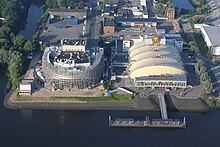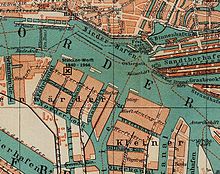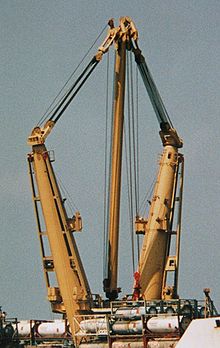Stülcken shipyard
| HC Stülcken son | |
|---|---|
| legal form | one-man business |
| founding | 1846 |
| resolution | 1967 |
| Seat | Hamburg |
| Branch | Shipyard |
The HC Stülcken Sohn (also Stülckenwerft) shipyard was one of the large shipyards in Hamburg . The company founded in Hamburg-Steinwerder in 1846 was located directly on the Norderelbe between the ferry canal and the Reiherstieg shipyard and was closed after the takeover by Blohm + Voss at the end of the 1960s.
A large part of the former shipyard area is taken up by two musical theaters of Stage Entertainment Germany . The port theater built in 1994 (today Theater im Hafen Hamburg ) has been performing the musical " The Lion King " since the end of 2001 ; right next to it, the new theater on the Elbe opened in November 2014 with the musical “ The Miracle of Bern ” .


history
The beginnings
From 1833 Johann Hinrich Friedrich Stülcken worked as a shipbuilder in various positions in Altona and Hamburg. His son Heinrich Christopher Stülcken rented land for a sailing shipyard in 1846. After only repairs were initially carried out, Stülcken built the Bark Hermann as the first new building in 1853 . A wooden floating dock , the first in Hamburg, was built in 1858 and was in operation until 1911. In 1868 he took over the neighboring area, where his father ran a small shipyard from 1845 to 1852. Heinrich Christopher Stülcken built around 20 wooden sailing ships, mostly barges, but also 2 pilot schooners, until he began building iron ships around 1876 .
HC Stülcken Sohn (from 1892)
Heinrich Christopher Stülcken died in 1873; his widow Dorothea continued to run the shipyard under the name HC Stülcken Wwe . After the company expanded in 1884, the first steam engine for ships was built in 1885 . After his mother's death in 1892, the son Julius Caesar Stülcken took over the business, which was now called HC Stülcken Sohn . Around 1890 Stülcken was one of eight shipyards in Hamburg that built seagoing ships with steel hulls . The orders for the construction and repair of wooden sailing ships decreased more and more at the beginning of the 20th century. This is one of the reasons why the construction of tug steamers was started with Willy in 1883 and the construction of fish steamers with the Neptun in 1904 as new branches of business. In 1913 a small cargo steamer was launched. It developed into one of the large shipyards in Hamburg; In 1914 it had 895 employees. At the beginning of the First World War, the Stülckenwerft converted fish steamers into outpost boats ; however, there were no further orders from the Imperial Navy . As a sub-supplier to the Germania shipyard in Kiel, the hull of the SM U 157 was built at Stülcken - originally a commercial submarine . The end of the war prevented the construction of further ships for the Navy. From 1923 the company built eight fishing trawlers and two fishing steamers for their own use. The fishing fleet was sold in 1926. The company was converted into a limited partnership before the death of Caesar Stülcken in 1925. Heinrich von Dietlein, the oldest grandson of the founder HC Stülcken, became the new boss.
Second World War
After the seizure of power of the Nazis , the H. C. Stülcken Sohn benefited from the programs to upgrade the armed forces in the German Reich . One of the first orders was the construction of four gunboats of the type Gunboat 1938 ( K 1 to K 4 ). The order was placed on November 11, 1938 and the ships were originally supposed to be commissioned between May 1941 and February 1942. However, construction work was not started on any of the ships ordered. Finally, the order was canceled again on September 19, 1939. The modernization planned during the First World War was carried out from 1939 onwards with the expansion of the site and the construction of a 230 meter long cable crane system over an enlarged slipway . The work with a grant from the Navy of 7 million Reichsmarks (one third of the sum) lasted from February 1940 to the end of 1942. The two distinctive scaffolding of the cable crane system was a landmark of the Hamburg port for decades.
Despite renovation work, the shipyard was commissioned to build type VII C submarines as early as 1940 . In 1942 an annual delivery of eight submarines with the use of 1,550 workers was planned. A department set up specifically for this purpose was able to produce twelve diesel engines for submarines every year . From 1941 to 1944 the shipyard delivered a total of 24 boats. Since the Kriegsmarine lacked escort ships, the 1941 escort boat was developed in 1942 based on the 1938 gunboat . This should also be built at Stülcken. The shipyard received the order for the first four ships ( G 1 to G 4 ), while the remaining twenty were to be manufactured in the Netherlands. The ship G 1 was laid down on November 25, 1942, but construction work was stopped in May 1943. The unfinished ship was later destroyed in a bomb attack. Preparatory work on G 2 is said to have already started, but all construction contracts between 1942 and 1943 were canceled again.
From 1943 Stülcken was only intended as a sub-supplier for the construction of the shell section of the Type XXI submarines , which were to be completed at the German works in Kiel and the Danzig shipyard . From the beginning of 1944, the shipyard was the sole manufacturer of the multi-purpose boat 1943 , a class of small escort ships. In total, Stülcken completed one boat and three more were still under construction at the end of the war. In November 1944, a satellite camp of the Neuengamme concentration camp for 250 Hungarian Jews was set up on the company premises . Germans and Dutch were used as kapos .
During the war, the Stülckenwerft was badly damaged by Operation Gomorrah in mid-1943 and by further air raids in mid-1944; after two renewed attacks on January 17 and March 11, 1945, continued operation was no longer possible.
post war period
After the reconstruction from 1948, the shipyard developed the so-called Stülcken heavy lift tree in the 1950s , a heavy lift harness that consists of two typically arranged heavy lift masts in a V shape. With the help of the loading gear , which in its most powerful variant had a lifting force of up to 350 t individually or up to 600 t piece goods with two loading gear used in combination, even the heaviest goods could be loaded without the use of an additional harbor crane . HC Stülcken as the shipyard and DDG Hansa as the shipping company in Bremen thus assumed a central market position in seaborne heavy transport. Heavy cargo trees according to the Stülcken construction are still in use today on general cargo and heavy lift ships. The main advantages of the Stülcken heavy lift tree are the low construction costs and easy maintenance. Under construction number 808, Adele was commissioned by the Swiss Migros to build the largest cargo ship ever built by the shipyard in 1952 .
resolution
In addition, the Stülcken shipyard was able to develop into the leading German shipyard for surface combat ships for the German Navy through the construction of class 101 / 101A destroyers (Hamburg class) and class 120 frigates (Cologne class) . In 1959 it was still considered a major shipyard, but the order situation fell during the shipyard crisis in the early 1960s. The shipyard was taken over by Blohm + Voss in 1966, which completed the new buildings that Stülcken had begun. The last ship, the Steigerwald , a mining transporter of Sachsenwald class for the German navy, was on 10 March 1967 by the stack. The shipyard facilities were then dismantled and the site lay fallow. A total of around 930 ships were built by this Hamburg shipyard, including around 60 warships.
Afterlife
In 1988 the area was returned to the city of Hamburg and finally leveled. Due to high pollution and mineral oil pollution, contaminated sites were remedied with soil replacement until 1991, the costs amounted to the equivalent of 9.1 million euros.
Today, most of the site is used by Stage Entertainment Germany , which has been presenting the musical " The Lion King " since November 2001 in the Theater im Hafen Hamburg . The directly adjacent Theater on the Elbe opened in November 2014 with the musical “The Miracle of Bern” based on the film of the same name .
See also
Web links
Individual evidence
- ↑ Marchtaler, Hildegard von (1940): Hundert Jahre Stülcken-Werft 1840-1940.- 261 p., Hamburg (printed by Broschek & Co.).
- ^ Herbert Karting: Itzehoer Schifffahrtschronik , Edition Falkenberg, 2015, p. 388, ISBN 9783954940523
- ↑ Gunboat 1938 on german-navy.de (Engl.)
- ↑ Corresponds to € 28,500,000 in today's currency, adjusted for inflation. The figure was based on the template: Inflation determined, has been rounded to ten thousand euros and relates to the previous January.
- ^ Arnold Kludas, Dieter Maass, Susanne Sabisch: Port of Hamburg. The history of the Hamburg free port from its beginnings to the present , Hamburg 1988, ISBN 3-8225-0089-5 , p. 348 ff.
- ↑ uboat.net (engl.)
- ↑ Chaser 1941 (Engl.) On german-navy.de
- ^ Hieke, Ernst, (1955): HC Stülcken Sohn. A German shipyard fate.- Hanseatischer Merkur, Hamburg, publications of the economic history research center, vol. 14: 374 p. and numerous Photo boards with pictures of the ships, as well as 4 folded boards, in the appendix extensive construction list 1853–1955 (year of construction, ship name, shipowner or customer, technical data and silhouette on a scale of 1: 2000)
- ↑ Shipping and shipbuilding (October 16, 1952): The ship of the week ( http://www.swiss-ships.ch/reeder/reederei-berichte/rz-migros/SUNADELE-Bericht-Schiffahrt&Schiffbau.pdf swiss-ships.ch )
- ↑ Anonymous, (1964) : HC Stülcken, Shipyard and Mechanical Workshop.- Hamburg.
- ^ Authority for Urban Development and the Environment [1] , accessed on April 18, 2009
Coordinates: 53 ° 32 ′ 27.8 " N , 9 ° 58 ′ 16.6" E



